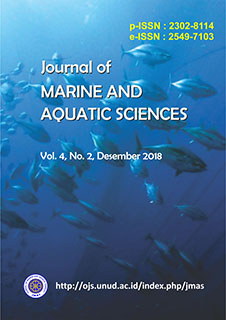Laju Pertumbuhan Kerang Abalon Haliotis squamata Melalui Budidaya IMTA (Integrated Multi Trophic Aquaculture) di Pantai Geger, Nusa Dua, Kabupaten Badung, Provinsi Bali
Abstract
Abalone is an important non fishery commodity that has high potential value to be developed. Abalone culture still faces some problems, such as, relatively slow growth rate, low survival rate and causing environmental pollution. One of the efforts to tackle the problems, is applying the culture system that is environmental friendly, such as IMTA (Integrated Multitrophic Aquaculture). This research aims to identify the growth rate and survival rate of the abalone (Haliotis squamata) and the suitability of chemical and physical environment parameter supporting the integration culture of abalone and seaweed (Gracilaria sp) on different stocking density at Geger beach, Nusa Dua, Bali. This research was performed in 45 days using a complete randomized design method that consist of three treatments and three repetition. The result showed that the highet growth rate was on treat ment T3 which consisted of abalone (Haliotis squamata) 40 individu and 10 bunches of seaweed (Gracilaria sp) 100 grams weight/each individu (0.76%/day), then It followed by T2 treatment that was integrated with 10 bunches of seaweed 50 grams (0.71%/day). The lowest growth rate observed on treatment T1 (control/monoculture) which consisted of 40 individu abalone (Haliotis squamata) (0.59%/day). The highest survival rate found on treatment T2 (97.5%) and followed by treatment T1 as control (94.5%), while the lowest number was found on treatment T3 (83.3%). Physical chemical water quality parameters showed that It supported the growth of both, abalone (Haliotis squamata) and seaweed (Gracilaria sp.) at Geger Beach, Nusa Dua, Badung Regency, Bali Province.
Downloads

This work is licensed under a Creative Commons Attribution 3.0 International License.
Copyright 2012 - 2023 Journal of Marine and Aquatic Sciences (JMAS)
Published by Fakultas Kelautan dan Perikanan Universitas Udayana, Denpasar, Bali, Indonesia
JMAS (p-ISSN 2302-8114; e-ISSN 2549-7103)


